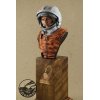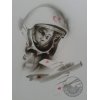The first…
On 12 April 1961 at 6:06:59 UTC, carrier the rocket Vostok-K, serial number E10316, blasted off from the Baikonur Cosmodrome. At 6:18:28 UTC it went into earth orbit, and along with the spacecraft Vostok-1 it put history’s very first cosmonaut into orbit, Senior Lieutenant Yuri Alekseyevich Gagarin, who 108 minutes later, at 8:05 UTC, parachuted back to earth near the village of Smelovka, now with the rank of major. Y.A. Gagarin returned from space as an international celebrity, with all the pluses and minuses that go with such status.
Yuri A. Gagarin was the ideal candidate to be the first man in space - an excellent athlete, a great student, capable of analysing and unexpected situation quickly, a member of the Soviet Union Communist Party and with a perfect proletarian background. He was born on 9 March 1934 in the town of Klushino to Anna Timofeyevna and Alexey Ivanovich Gagarin, respectively a milkmaid and carpenter at the local cowshed. On 1 September 1941 Yuri started year one at the local school. By the end of summer 1941 he had decided to become a pilot after watching two aeroplanes land, and young Yuri remained forever enthralled by the beautiful machines and wide blue yonder. On 24 May 1945, after the end of the war, the family moved to the town of Gzhatsk. In 1949 Yuri completed year 6 of secondary school and was accepted at the Lyubertsy foundry apprentice training school. After one year of excellent results he was selected for study at the Saratov technical school, and he also had his first flight at the local flying club. In 1955 he was accepted for the First Chkalov Air Force Pilot's School in Orenburg. On 8 January 1956 he became a professional serviceman, and on 26 March he soloed for the first time in a MIG-15. In October the newlywed Y.A.Gagarin took his state examination and joined the polar air force at the Nikel Airbase.
In October 1959 a selection procedure was commenced starting with approximately 3000 selected pilots and ending with the group of twenty who made up the first cosmonaut squad. Yuri was one of twenty. On 11 March 1960 he moved to Moscow with his family, and on 14 March he started the most demanding training that any candidates had yet undergone. On 18 June the candidates were invited to the office of the chief designer and architect of the Soviet space programme, Sergej Korolev, and visited the OKB-1 production plant. Gagarin’s demeanour made such an impression on Korolev that he became his favourite and the main candidate. In the summer of 1960 the candidates were cut down to an elite group of six who had absolute precedence in further training. On 17 January 1961 practical tests on a simulator began on the basis of which a group of three candidates was selected for the first flight in the order, Gagarin, Titov and Nelyubov. In the next stage of hard preparation the group of three was reduced to the pair of Gagarin and Titov. On 5 April both candidates flew, each on a different plane, to the cosmodrome, and on 8 April 1961 Y.A. Gagarin was named the first candidate for man's first ever flight to space. G. S. Titov became his substitute.
Both candidates were monitored by a team of doctors up to virtually the last moment before blast off. Even during the last night the beds were connected to monitors, and so both men merely pretended to be sleeping deeply and peacefully. For the entire period of the pre-flight preparation Gagarin was completely calm, and his pulse was a mere 64 beats per minute. With the blast off and a cry of Поехали! Yuri Gagarin opened up a new era in the conquest of space.
For the rest of his life he tried to return to space, in spite of his role as a Soviet national hero. In the summer of 1966 he was selected as the substitute of Vladimir Komarov for the flight of Sojuz-1. On 23 April 1967 at 00:35 UTC, Sojuz-1 blasted off with Komarov on board, but his flight was plagued with serious problems, and after just one day in orbit the descent module was smashed to pieces on the steppe near Orenburg as the result of a parachute failure. Komarov died on the spot. This was also the end of any hope that Y. Gagarin had of returning to space – the Soviet Union could not afford to lose a national icon.
On 27 May 1968, during adaptation training for the MiG-17, Yuri Gagarin took a training flight with the instructor Vladimir Seryogin in a MiG-15 UTI (manufactured under number 612739 at the Aero Vodochody plant). At 13:31 UTC Gagarin last contacted air traffic control, and a few seconds later Gagarin's call sign 625 fell forever silent for reasons not known to this day. The plane crashed near the village of Kirzhach - both pilots were found dead.
Gagarin’s legacy was best summed up by Neil Armstrong, who said of him: “He invited us all into space”.
Source: www.kosmonautix.cz
Content: bust - 3 resin parts, photoetched parts, mask - stencil for sign airbrushing, tinned copper wire, brochure, sticker.






















